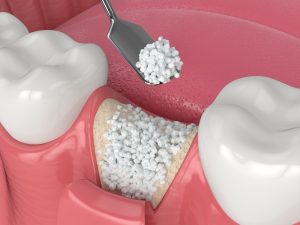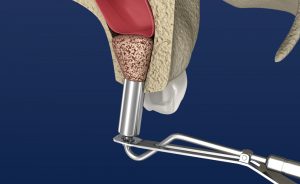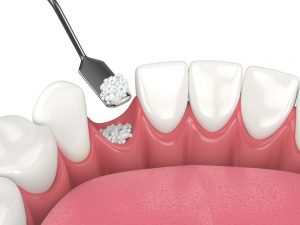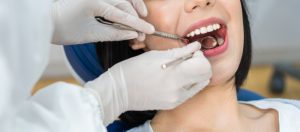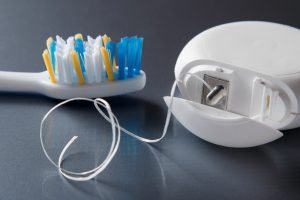Rebuilding Bones for Better Smiles & Implant Success
Are you dealing with dental issues due to lost bone density? Are you trying to restore your smile with dental implants, but may not qualify due to bone loss? At our San Luis Obispo practice, lead dentist Dr. Carrie Ramirez and our dental team offer a solution with bone grafting procedures.
Embarking on a journey toward a stronger, healthier smile begins with understanding the transformative world of dental bone grafting. Learn more about bone grafting, an essential procedure that lays the groundwork for lasting oral health, by dialing (805) 549-8483.
What is Bone Grafting?
Bone grafting is a sophisticated dental procedure designed to restore or augment bone tissue in the jaw. This critical process becomes necessary when the jawbone lacks the necessary density to support dental implants, bridges, or other restorative treatments. Dr. Ramirez and her team specialize in various bone grafting techniques, tailoring each approach to meet the unique needs of their patients.
Types of Bone Grafting Procedures
Ridge Augmentation
Ridge augmentation reshapes the jawbone, addressing irregularities and enhancing its aesthetic appeal. The process involves carefully augmenting or recontouring the upper portion of the jaw bone to create a smoother and more harmonious bone structure. It also provides patients with a jawbone that not only supports dental implants but also contributes to an aesthetically pleasing facial appearance. Reshaping the ridge ensures a natural and symmetrical alignment of the teeth, contributing to a more attractive smile.
Sinus Lift
A sinus lift, also known as sinus augmentation, is a specialized surgical procedure often performed to augment the upper jawbone, specifically in the region of the molars and premolars. This intricate procedure involves lifting the sinus membrane and adding dental bone grafts and material to facilitate the growth of new bone in the upper jaw.
Sinus lift surgery is particularly beneficial for patients with insufficient bone in the upper jaw, providing additional support for dental implants. By increasing the bone volume in the sinus area, this procedure opens up possibilities for successful implant placement, even in challenging cases.
Sinus lift contributes not only to the structural support of dental implants but also improves overall oral function and facial aesthetics. The procedure addresses bone deficiencies in the upper jaw, preventing issues such as facial collapse and maintaining facial contours.
Socket Preservation
Socket preservation is a vital step following tooth extraction, designed to maintain the bone structure of missing teeth and prevent subsequent bone loss. This procedure creates an optimal environment for future dental implants by preserving the natural contours of the jaw.
After tooth extraction, the socket preservation process involves placing grafting bone material into the extraction site, minimizing the resorption of bone that typically occurs after tooth removal. Preserving the healthy bone structure ensures a more stable foundation for any future restorative dental work.
Socket preservation also sets the stage for successful dental implant placement by preventing the collapse of the extraction site and maintaining the volume of the surrounding bone. The procedure is especially crucial for individuals considering dental implants in the future, ensuring a more predictable and effective implant procedure.
Nerve Lateralization
Nerve lateralization addresses nerve-related issues that may impact the safe and effective placement of dental implants. This procedure is crucial for patients with specific anatomical challenges, ensuring the protection of nerves during dental implant surgery.
Nerve lateralization also allows for the precise repositioning of nerves in the jaw, creating a safe pathway for the placement of dental implants. By addressing nerve-related concerns, this technique enhances the success rate of implant procedures while prioritizing patient safety.
Materials for Bone Grafting Procedures
Bone grafting materials play a crucial role in the success of the procedure. Dr. Ramirez utilizes a variety of options for dental bone graft surgery, including:
- Xenograft: Derived from animal sources
- Allograft: Harvested from human donors
- Autograft: Utilizing bone from another site in your body
- Cortical Bone Graft: Extracted from dense outer layers of the bone
- Growth Factors: Enhancing the regenerative capacity of the bone
Benefits of Bone Grafting Procedures
Bone grafting procedures offer numerous benefits, including:
- Bone Density Improvement: Bone grafting stimulates the growth of new bone tissue, enhancing the overall density and strength of the jawbone.
- Enhanced Chewing Ability: Restoring bone density enables patients to chew more effectively, improving their ability to enjoy a varied and nutritious diet.
- Speech Improvement: Bone grafting can positively impact speech patterns by providing greater stability to oral structures.
- Support for Soft Tissues: A stronger jawbone provides better support for facial muscles and soft tissues, contributing to a more youthful and aesthetically pleasing appearance.
- Dental Implant Success: Bone grafting significantly increases the success rate of dental implant procedures by ensuring there is sufficient bone for implant placement.
- Compatibility with Bridges and Dentures: Patients with bone grafts often find increased options for restorative treatments, including dental bridges and full or partial dentures that provide a secure and natural-looking solution.
- Prevention of Bone Resorption: Bone grafting minimizes the risk of adjacent teeth shifting or bone resorption, preserving the overall stability of the dental arch.
- Reduced Risk of Complications: A well-executed bone grafting procedure minimizes the risk of complications associated with tooth loss, such as gum recession and further bone deterioration.
- Prevention of TMJ Issues: Improved jawbone structure contributes to a more balanced bite, reducing the risk of temporomandibular joint (TMJ) issues.
- Boosted Confidence: Restoring the structural integrity of the jawbone can have a positive impact on self-esteem and confidence, especially for individuals who have experienced tooth loss.
- Improved Nutrition: The ability to chew more effectively enhances the intake of essential nutrients, positively impacting overall health.
Who Qualifies for Bone Grafting Procedures?
You may qualify for a bone grafting procedure if any of the following apply to you:
- Insufficient Jawbone Density: Individuals with naturally low bone density in the jaw, which may be a result of genetics or other factors, may qualify for bone grafting to ensure proper support for dental implants.
- Tooth Loss or Extraction: Patients who have lost one or more teeth or undergone tooth extractions, leading to a decrease in bone volume, may qualify for bone grafting to restore the structural integrity of the jaw.
- Planning for Dental Implants: Those considering dental implants as a restorative option require sufficient bone for successful implant placement. Bone grafting can be recommended to augment bone density and support implant stability.
- History of Periodontal Disease: Individuals with a history of periodontal disease, which can lead to bone loss in the jaw, may qualify for bone grafting to address and prevent further deterioration.
- Facial Trauma or Injury: Patients who have experienced facial trauma or injury resulting in bone loss in the jaw may be eligible for bone grafting to repair and regenerate damaged bone tissue.
- Preparation for Orthodontic Treatments: Individuals planning for orthodontic treatments, such as braces or aligners, may require bone grafting to ensure proper bone support for the repositioning of teeth.
- Existing Dental Restorations: Patients with existing dental restorations, such as bridges or dentures, may qualify for bone grafting if these restorations have contributed to bone loss or if additional support is needed for an implant-retained restoration.
- Medical Conditions Affecting Bone Health: Individuals with medical conditions affecting bone health, such as osteoporosis or certain metabolic disorders, may be eligible for bone grafting to address compromised jawbone density.
- Smokers: Smokers, who may experience slower healing and increased risk of complications, may qualify for bone grafting with careful consideration of their overall health and commitment to postoperative care.
- A Desire for Facial Aesthetics: Patients seeking enhanced facial aesthetics or addressing issues related to facial collapse may be considered for bone grafting to maintain natural facial contours.
The Bone Grafting Process
Consultation
Dr. Ramirez begins the bone grafting process with a comprehensive examination of your oral health. This includes assessing the current state of the jawbone, identifying areas of bone deficiency, and evaluating the overall condition of the oral tissues. Dr. Ramirez and her team will also thoroughly review your medical history, addressing any pre-existing conditions or medications that might impact the procedure.
Based on the examination findings, Dr. Ramirez will have a detailed discussion with you about the necessity for bone grafting, outlining potential treatment options, and addressing any questions or concerns you may have. Based on her findings, Dr. Ramirez tailors a customized bone grafting plan that aligns with your unique needs and goals.
Bone Grafting Preparation
On the day of the bone grafting procedure, Dr. Ramirez provides a detailed explanation of the steps involved. This includes a discussion of the chosen grafting material, the specific technique to be employed, and the expected outcomes.
To ensure a pain-free experience, local or general anesthesia is administered as per your comfort level and the complexity of the procedure. Dr. Ramirez and her team prioritize patient well-being throughout the process.
Precision Placement of Grafting Material
Dr. Ramirez skillfully places the chosen grafting material at the targeted site(s), precisely addressing the areas identified during the consultation phase. This graft material completely serves as a scaffold, stimulating the body’s natural bone growth and regeneration processes.
Bone Grafting Aftercare
After undergoing a bone grafting procedure, attentive and consistent aftercare plays a pivotal role in ensuring optimal healing and the long-term success of the treatment. Dr. Ramirez and the dedicated team at our San Luis Obispo practice provide detailed guidelines to support patients during the crucial postoperative period. Some include:
- Monitoring and Managing Discomfort: Dr. Ramirez may prescribe pain medications or recommend over-the-counter pain relievers to manage any discomfort. It’s essential to follow the prescribed dosage and frequency for effective pain control.
- Cold Compress Application: Applying a cold compress to the treated area in the initial 24 hours can help reduce swelling and alleviate discomfort. Patients are advised to use a cloth or towel to protect the skin and apply the compress for short intervals.
- Diet Recommendations: Patients are advised to stick to a soft diet during the initial days. This includes soups, yogurt, mashed potatoes, and other easily chewable foods. Patients should also refrain from consuming crunchy, or excessively hot foods that could potentially disrupt the healing process or cause discomfort.
- Gentle Toothbrushing: Maintaining oral hygiene is crucial, but patients should use a soft-bristled toothbrush and exercise gentle brushing around the surgical area. Dr. Ramirez provides specific instructions on when and how to resume regular brushing.
- Rinsing with Saline Solution: Patients may be advised to rinse their mouths with a prescribed saline solution to keep the surgical site clean. This helps prevent infection and promotes a healthy healing environment.
- Tobacco Cessation: Patients who smoke are strongly encouraged to refrain from tobacco use during the healing period. Smoking can hinder the body’s ability to heal and increase the risk of complications.
- Limiting Alcohol Consumption: While moderate alcohol consumption may be permissible, excessive alcohol intake should be avoided, as it can potentially interfere with the healing process and compromise the success of the bone graft.
- Regular Monitoring: Dr. Ramirez schedules follow-up appointments to monitor your progress and assess the success of the bone graft. These appointments allow for any necessary adjustments to the aftercare plan and provide an opportunity to address any concerns or questions.
- Avoiding Strenuous Activities: Patients are advised to avoid strenuous activities, especially in the initial days following the procedure, to minimize the risk of complications and promote a smoother recovery.
Frequently Asked Questions
The duration of the bone grafting process can vary based on the complexity of the procedure, the specific type of bone graft performed, and individual healing factors. The process may take several months, allowing sufficient time for the grafting material to integrate with the existing healthy bone tissue and promote regeneration. Your dentist will provide a personalized timeline during the consultation based on your unique case.
During the bone grafting procedure, patients experience minimal discomfort due to the administration of local or general anesthesia. After the surgery, some soreness or swelling may occur, but this can be effectively managed with prescribed or over-the-counter pain medications. Dentists prioritize patient comfort, and measures are taken to ensure a painless experience throughout the process.
While bone grafting is a generally safe and common dental procedure, like any surgical intervention, it carries some inherent risks. Potential risks include infection, bleeding, or complications related to anesthesia. Your dentist will thoroughly discuss these risks during the consultation, and steps will be taken to minimize them through meticulous planning, adherence to hygiene protocols, and close postoperative monitoring.
Coverage for bone grafting varies depending on the specific insurance plan and the nature of the procedure. Dental insurance may cover bone grafting if deemed medically necessary for oral health, especially in cases related to dental implants.
Medical insurance might provide coverage if bone grafting is required due to a medical condition or trauma. Review your insurance policies, communicate directly with your insurance providers, and explore payment plans or financing options if there are out-of-pocket costs for bone graft surgery.
Get The Stable Foundation You Need For Optimal Oral Health, Call Today!
Dr. Ramirez and her team are committed to transforming smiles through personalized bone grafting solutions. Contact our office at (805) 549-8483 to schedule a consultation and take the first step towards a stronger, more resilient smile. We serve San Luis Obispo and surrounding areas such as Santa Margarita, Arroyo Grande, and Pismo Beach, CA. Uncover the potential of your oral health with bone grafting; the foundation for a brighter, healthier smile.
